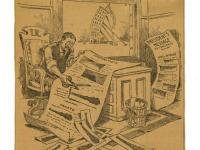With less than three months left on the Historic Images, New Technologies (HINT) project, we’ve more or less wrapped up our TEI encoding of political cartoons and are concentrating on getting our exhibit website working and on writing biographies and descriptions of the people, organizations, and symbols associated with our cartoons.
At the outset of this project, we set ourselves the lofty goal of digitizing, researching, and richly encoding 500 political cartoons from the Historical Society of Pennsylvania’s collections. We did succeed in selecting, digitizing, and researching over 500 cartoons, but we found that the detail-intensive work that goes into encoding and annotating political cartoons took longer than we anticipated.
Some cartoons are more complicated than others.
To give you an idea of the work involved, for each digitized cartoon we:
- Encode all relevant metadata (title, date, publication information, collection/citation info, etc.)
- Write a description of the image
- Identify all people, organizations, and symbols associated with the cartoon
- Transcribe all text in the cartoon and, when appropriate, write additional annotations to explain or illuminate significant non-textual details
- Draw zones on the image that connect visual details with pop-up text boxes (see this blog post for an explanation of how this works).
It became clear to us that we could either produce an exhibit with more cartoons but less detail, or we could scale back the number of cartoons to encode and devote more time and attention to each. We decided on the latter option.
All cartoons that have been used in the educational unit and lesson plans devised by HSP’s education manager, Alicia Parks (see links on project homepage) as well as a subset of 30 “featured” cartoons selected from across major chronological eras have received particularly rich description and annotation—in addition to transcribing all text in the image, providing an image description that explains the historical context and meaning of each cartoon, and highlighting all identifiable symbols, we are linking to biographies and descriptions of all people and organizations that are associated with these cartoons, whether artists, publishers, or historic figures who are depicted or mentioned in the cartoon itself.
The rest of the cartoons in the exhibit, encoded to what we are calling “basic” level, contain slightly less contextual detail, but still provide image descriptions, transcription of all text, and identifications of all people, organizations, or obvious symbols that appear in the cartoon.
No matter what the level of encoding, all cartoons in the final exhibit will have zones drawn on them and can be explored using the enhanced features of the new HSP Image Viewer.
In all, we’re looking at an exhibit featuring more than 125 richly annotated and interactive political cartoons from 1754 through the early 20th century. And the remaining cartoons we selected but won’t have time to richly encode? They are still digitized and viewable right now at HSP’s Digital Library.


![Political cartoon: The Siege of Zion, 1787 [Zion Besieged and Attacked]](/sites/default/files/11731-bc612z267_1.jpg)